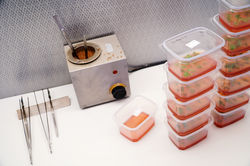 In order to produce a high number of genetically identical, pathogen-free raspberry plants in a short time, selected clones of desired varieties are micropropagated in our laboratory under sterile and controlled conditions.
In order to produce a high number of genetically identical, pathogen-free raspberry plants in a short time, selected clones of desired varieties are micropropagated in our laboratory under sterile and controlled conditions.
Preparing the plant material for establishment
The first preparatory step for establishing raspberries in the laboratory is the cultivation and selection of the mother plants in the greenhouse. Defined, virus-tested plants are cultivated in standard substrate. The meristems of canes from the winter and spring can be used for the in vitro establishment of raspberries. Woody winter canes are cut off and grown at room temperature in a water glass on the windowsill. The canes sprout after one to two weeks. As soon as the shoot is two to three centimetres long, it can be cut off from the old wood and sterilised. On the other hand, the fresh juvenile plant material can be used for establishment in the second quarter of the year. These fresh shoots are then cut directly into individual nodes and sterilised.
Removing adhering fungi and bacteria by means of sterilisation
Optimum concentration of the sterilisation solution and incubation time is always a compromise between the possibility of killing microorganisms on the one hand and not impairing the vitality of the plant meristem on the other. Depending on the condition of the plant material, the concentration and incubation time of the sterilisation solution is specifically adjusted.
Sodium hypochlorite or ethanol is usually used as the disinfectant solution. The plant material incubates for approximately 20 to 30 minutes in the disinfectant solution and is shaken. This surface sterilisation is used to kill off any microorganisms that may have adhered to the material in order to avoid contamination with bacteria and fungi in the subsequent culture. However, endophytes may escape from explants and become visible on the nutrient solution as the cultivation progresses. In a sterile workbench, the sterilising solution is removed and the plant material washed with autoclaved distilled water in order to remove chlorine or ethanol residues. These could inhibit the explant growth and have a negative effect on the further development of the small plants.
The use of whole nodes or prepared axillary buds
In the first step, nodes or axillary buds can be placed on nutrient solution. In the case of young canes, a variety-specific decision is made as to whether the establishment should be carried out using whole nodes or removed axillary buds and this depends on which method was more suitable in the past for budding the respective variety. The direct insertion of nodes without preparation is not possible with winter canes because the old wood is susceptible to contamination. A complete sterilisation without damage of the meristem, due to a highly concentrated disinfection solution, cannot be accomplished. Therefore, the axillary buds of winter canes should be prepared with the help of magnification using a binocular microscope and the outer tissue layers of these buds should be peeled off. This peeling is also carried out on juvenile material depending on the size of the buds. This peeling is not necessary for very small, very young axillary buds. Several axillary buds can be placed in a petri dish with nutrient solution, provided that the culture vessels are regularly inspected so that sterile meristems can be separated from non-sterile ones.
Culture medium for growth, differentiation and propagation
The nutrient solution provides the meristems used with the necessary nutrients, vitamins and salts for further growth. Since the in vitro plants do not photosynthesise, sugar is added to the nutrient solution as a foreign carbon source. To solidify the medium, agar is added as a gelling agent. Natural or synthetic plant growth regulators are also added to stimulate the division and differentiation of meristem cells. The explants develop into small plants that reproduce and are genetically identical to the original plant. The fresh propagations are divided with a sterile scalpel and transferred to a new nutrient solution. Through continuous repetition of cutting and transplanting, the plant material can be selectively propagated.
Click here for more information.
Would you like more information, an individual consultation or information about additional ranges?
Click here for the complete 2019 catalogue, which can be downloaded.
If you have specific questions, please do not hesitate to contact our customer service, where you can also spontaneously place an order.
And of course we are always there for you via telephone.
If you want to be regularly informed about news, etc., you can also subscribe to our gardener newsletter here, which we send out about once a month - it's worth it!
